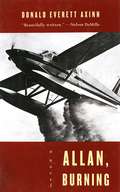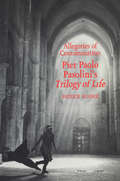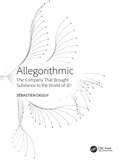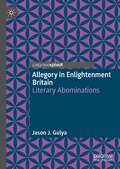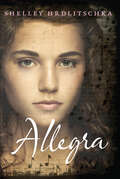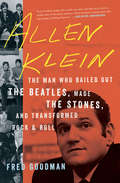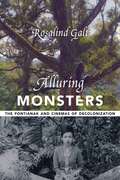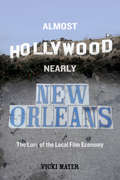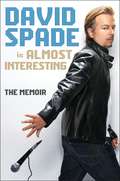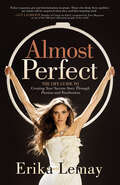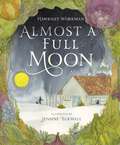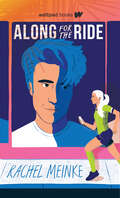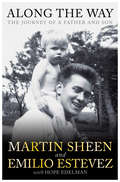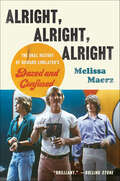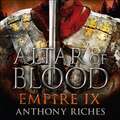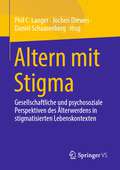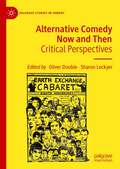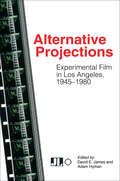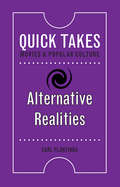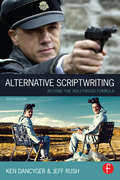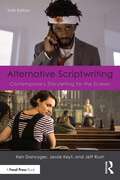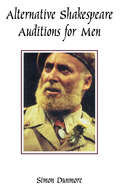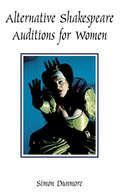- Table View
- List View
Allan King's A Married Couple
by Zoe DruickLong before 'Reality TV,' Canadian filmmaker Allan King caused a stir by mixing people's private and public lives in his 1969 documentary A Married Couple. This observational cinema piece, which took an unscripted look at the urban Edwards family, was deemed too contentious to air by commissioning network CTV on the grounds of excessive nudity and obscenity. Nevertheless, the documentary was accepted by the Cannes festival, and it is now cited as a milestone in realist filmmaking.In Allan King's A Married Couple, Zoë Druick examines the film in the context of late 1960s cinematic and cultural movements. Through a scene-by-scene synopsis and an analysis of contemporary responses to the piece, she traces A Married Couple's influence on documentary and Canadian filmmaking. The fifth volume in the Canadian Cinema series, this work is an accessible and engaging introduction to a controversial film and its fascinating director.
Allan, Burning: A Novel
by Donald Everett AxinnHappily married with two beautiful children, successful architect and avid amateur aviator Allan Daniels finds his life plummeting into a nightmare when his wife suddenly announces that she wants a separation, maybe a divorce. Then, two days later, as he is piloting a seaplane from Long Island to Key West, the engine of his Cessna 185 seaplane sputters, then quits. Daniels's resolute skills as a pilot enable him to land safely in the Everglades, where a disheveled Miccosukee man named Tommy Handley finds him. But while Handley turns out to be from the same tribe as Daniels's mother, he also turns out to be a fugitive from justice, hiding out and evading capture in the protection of the remote swamps. When Daniels wakes in the middle of the night to find Handley groping for his wallet, Daniels defends himself--but accidentally kills his rescuer, then flees in his boat, from which locals later rescue him again. Daniels's explanation of what happened in the swamp doesn't sit well with savvy local lawman Sheriff Haskins, who suspects that Daniels is hiding something--but what? When Daniels finally confesses his guilt, it will set off a whole new chain of dire events in this fast-paced novel with enough twists and turns to keep you guessing until the final page.
Allegories of Contamination
by Patrick RumbleThe Trilogia della vita (Trilogy of Life) is a series of three films that Pier Paolo Pasolini completed before his horrifying assassination in 1975, and it remains among the most controversial of his cinematic works. In Allegories of Contamination Patrick Rumble provides an incisive critical and theoretical study of these films and the Marxist filmmaker's complex, original concept of the cinematic medium.With the three films that make up the Trilogy of Life - The Decameron, Canterbury Tales, and The Arabian Nights - Pasolini attempts to recapture the aura surrounding popular, predominantly oral forms of storytelling through a pro-modern vision of innocent, unalienated bodies and pleasures. In these works Pasolini appears to abandon the explicitly political engagement that marked his earlier works - films that led him to be identified with other radical filmmakers such as Bellocchio, Bertolucci, and Godard. However, Pasolini insisted that these were his 'most ideological films,' and his political engagement translates into a mannerist, anti-classical style or what he called a 'cinema of poetry.' Rumble offers a comparative study based on the concept of 'aesthetic contamination,' which is fundamental to the understanding of Pasolini's poetics. Aesthetic contamination concerns the mediation between different cultures and different historical moments. Through stylistic experimentation, the Trilogy of Life presents a genealogy of visual codes, an interrogation of the subjectivity of narrative cinema. In these films Pasolini celebrates life, and perhaps therein lies their simple heresy.
Allegorithmic: The Company That Brought Substance to the World of 3D
by Sébastien DeguyAllegorithmic: The Company That Brought Substance to the World of 3D explores the journey of Allegorithmic, the software company behind Substance, a suite of tools that revolutionized texturing in computer graphics. This engaging narrative by Sébastien Deguy, the visionary founder and CEO of the company, chronicles the growth of Allegorithmic from its inception as a small startup to becoming a leader in digital content creation, pivotal in shaping the visual aesthetics of video games and films.The book highlights key technological innovations and strategic decisions that propelled the company forward, offering a detailed look at the challenges and triumphs of developing cutting-edge software solutions while building a team attached to its strong values and passion for digital artists.Key Features: Provides a detailed history of Allegorithmic, a company at the forefront of technological innovation in procedural textures and 3D content. Covers significant technical ground, discussing complex environments, procedural textures, and software development, while also delving into the creative aspects of these technologies. Spans the growth of a startup into a major player in the tech industry, providing insights into business strategies, team building, and international expansion. Reflects on the cultural shifts within the company and the broader industry, offering lessons on adapting to technological advancements and market demands. Ideal for tech enthusiasts, artists, and entrepreneurs, this deep book provides a comprehensive overview of the creativity and perseverance required to influence and lead in the tech industry.
Allegory in Enlightenment Britain: Literary Abominations
by Jason J. GulyaThis Palgrave Pivot argues for the significance of allegory in Enlightenment writing. While eighteenth-century allegory has often been dismissed as an inadequate form, both in its time and in later scholarship, this short book reveals how Enlightenment writers adapted allegory to the cultural changes of the time. It examines how these writers analyzed earlier allegories with scientific precision and broke up allegory into parts to combine it with other genres. These experimentations in allegory reflected the effects of empiricism, secularization and a modern aesthetic that were transforming Enlightenment culture. Using a broad range of examples – including classics of the genre, eighteenth-century texts and periodicals – this book argues that the eighteenth century helped make allegory the flexible, protean literary form it is today.
Allegra
by Shelley HrdlitschkaAllegra thinks being at a performing-arts high school will change her life and make her a better dancer. But high school is still high school, complete with cliques, competition and cruelty. Allegra's refuge comes in the form of a class she doesn't want to take—music theory, taught by a very young, very attractive male teacher. Soon all Allegra can think about is music composition—and Mr. Rochelli. But has she misunderstood his attention, or is he really her soul mate?
Allen Klein: The Man Who Bailed Out the Beatles, Made the Stones, and Transformed Rock & Roll
by Fred GoodmanThe story of the notorious rock and roll manager, revealing new, behind-the-scenes details about some of the biggest bands in music history. Allen Klein was like no one the music industry had seen before. Though he became infamous for allegedly causing the Beatles&’ breakup and robbing the Rolling Stones, the truth is both more complex and more fascinating. As the manager of both groups—not to mention Sam Cooke, Pete Townshend, Donovan, The Kinks, and numerous others—he taught young soon-to-be legends how to be businessmen as well as rock stars. While Klein made millions for his clients, he was as merciless with them as he was with anyone, earning himself an outsize reputation for villainy that has gone unchallenged until now. Through unique, unprecedented access to Klein&’s archives, veteran music journalist Fred Goodman tells the full story of how the Beatles broke up, the Stones achieved the greatest commercial success in rock history, and the music business became what it is today. &“Fred Goodman makes this world come alive, and any fan of rock or insider tales of the music industry will be in heaven reading about this fascinating, troubling character.&” —Judd Apatow &“Writing about contracts, percentages and deals can be tedious, but Goodman makes it as exciting as reading about an artist&’s sex life. The book explodes with inside dope.&” —Daily News (New York) &“Succeed[s] both as a compelling work of rock-&’n&’-roll history and as a cautionary business primer.&” —The Wall Street Journal
Alluring Monsters: The Pontianak and Cinemas of Decolonization (Film and Culture Series)
by Rosalind GaltThe pontianak, a terrifying female vampire ghost, is a powerful figure in Malay cultures, as loved and feared in Southeast Asia as Dracula is in the West. In animist tradition, she is a woman who has died in childbirth, and her vengeful return upsets gender norms and social hierarchies. The pontianak first appeared on screen in late colonial Singapore in a series of popular films that combine indigenous animism and transnational production with the cultural and political force of the horror genre.In Alluring Monsters, Rosalind Galt explores how and why the pontianak found new life in postcolonial Southeast Asian film and society. She argues that the figure speaks to a series of intersecting anxieties: about femininity and modernity, globalization and indigeneity, racial and national identities, the relationship of Islam to animism, and heritage and environmental destruction. The pontianak offers abundant feminist potential, but her disruptive gender politics also unsettle queer and feminist film theories by putting them in dialogue with Malay epistemologies. Reading the pontianak as a precolonial figure of disturbance within postcolonial cultures, Galt reveals the importance of cinema to histories and theories of decolonization. From the horror films made by Cathay Keris and Shaw Studios in the 1950s and 1960s to contemporary film, television, art, and fiction in Malaysia and Singapore, the pontianak in all her media forms sheds light on how postcolonial identities are both developed and contested. In tracing the entanglements of Malay feminist animisms with postcolonial visual cultures, Alluring Monsters reveals how a “pontianak theory” can reshape understandings of anticolonial aesthetics and world cinema.
Almost Hollywood, Nearly New Orleans
by Vicki MayerAt publication date, a free ebook version of this title will be available through Luminos, University of California Press's Open Access publishing program. Visit www. luminosoa. org to learn more. Early in the twenty-first century, Louisiana, one of the poorest states in the United States, redirected millions in tax dollars from the public coffers in an effort to become the top location site globally for the production of Hollywood films and television series. Why would lawmakers support such a policy? Why would citizens accept the policy's uncomfortable effects on their economy and culture? Almost Hollywood, Nearly New Orleans addresses these questions through a study of the local and everyday experiences of the film economy in New Orleans, Louisiana--a city that has twice pursued the goal of becoming a movie production capital. From the silent era to today's Hollywood South, Vicki Mayer explains that the aura of a film economy is inseparable from a prevailing sense of home, even as it changes that place irrevocably.
Almost Interesting
by David SpadeI've learned over the last year that books are a lot harder to write than Twitter posts.--@davidspade (free plug)Welcome to my book, guys. Here are 200 pages of my blood, sweat, and jizz. It took a long time to write, and I hope you think it was worth it. These are the stories I tell to my friends or at dinner when I'm drunk and everyone darts their eyes around and squirms in their chair hoping I'll finish soon. Others I've told on Stern or Ellen or anyone else I can name-drop.It's me telling you about my fake problems in life and a few real ones (my neck is actually really a disaster). It is a book about comedy, and how I came up from the dusty roads of Arizona with my OP shorts and my blond fluffy hair, to the mean streets of Beverly Hills, with nothing but a few props in my mom's old honeymoon suitcase and a few dry jokes. I blather on about how I got into stand-up, how I lost my virginity, and meeting Johnny Carson, to my years on Saturday Night Live (I couldn't write decent sketches for shit for a long time), to making Tommy Boy with Farlz, to the time I got the shit kicked out of me by my assistant while I was wearing a Coneheads T-shirt . . . this is my memoir.So, anyway, take a minute . . . to buy this, you don't even have to read it, just gave away all the good parts, anyway. Who reads books, right? Fuck this, let's go do molly at Coachella!
Almost Like A Song
by Ronnie Milsap Tom CarterRonnie Milsap, a legend in country music, shares the story of his life including the obstacles and opportunities created by his blindness. He describes his childhood in the rural south and gives an insider's view of life at a school for the blind. He chronicles his entry into country music and shares stories about his travels.
Almost Perfect: The Life Guide to Creating Your Success Story Through Passion and Fearlessness
by Erika LemayThrough Almost Perfect, Erika Lemay shares how she became world-famous by creating a career out of her passion — the acrobatic world of Physical Poetry. The gritty detail of a life in the spotlight is exposed — rebuilding herself after a fall that left one of her limbs compromised and challenged all she had aspired to be, avoiding child abusers in the show business world, and keeping her cool when the unpredictable happens 30 metres in the air. More than this, Erika explains the methodology behind her success stories. With precise parameters, tips, and tricks, Almost Perfect is the guide she shares to a pain-free life, which explains how she maintains her physical conditions to Olympic-athlete level, and demonstrates how everyone can achieve the extraordinary — not by magical thinking but by designing a precise set of habits that can open doors to what most think is only accessible to the few. Almost Perfect is ideal for anyone that aspires to exceptional health, an extraordinary life, a head-turning physique, and an enviable career. Erika’s carefully crafted methodology for excelling at specific goals is laid bare for the world to see. Nothing comes for free: a detail-oriented and elite mindset is the key to the most incredible life-changing path. Throughout Almost Perfect, readers learn to be the incarnation of coherence through iron discipline and unshakeable self-worth.
Almost a Full Moon
by Hawksley WorkmanAlmost a Full Moon is a warm-hearted story of family, community, food and home. A boy and his grandmother host a gathering in their small cabin in the middle of winter. Friends travel from near and far, and some new friends even turn up. The walls of the cabin are elastic and the soup pot bottomless; all are welcome. Based on the lyrics of Hawksley Workman's song from his holiday album Almost a Full Moon, this book evokes both the cold and the coziness of a winter's night: crisp clean air, sparkling snow, the light of the moon, welcoming windows, glowing candles, family and friends. The spare text is beautifully complemented with the rich illustrations of Jensine Eckwall, a new talent to Tundra. She brings beauty and a hint of magic to Workman's evocative lyrics; together, they create a world and a night that will enchant readers of all ages.
Along for the Ride
by Rachel MeinkeThe worst summer of her life has one seriously hot perk . . .These days, everything in Katelyn Jackson’s life revolves around her pop star brother. His schedule, his tour, his fans—it’s like Connor Jackson’s become the center of the universe. And when the entire family decides to join Connor’s tour, Katelyn has to kiss her soccer team, her friends—and her entire summer—goodbye.The only good news is the opening act is none other than her favorite band with the hottest lead singer ever. Zach Matthews, with his deep caramel eyes, makes Katelyn’s heart pound a zillion beat per minute. Don’t mind me, I’m just fangirling over here.Between the endless bus rides and cruddy room service, some serious chemistry develops between Katelyn and Zach. But as they say, all is not fair in love and pop stardom and Katelyn will have to decide if she’s willing to take a risk or if she’s just along for the ride.
Along the Way
by Martin Sheen Emilio EstevezMARTIN SHEEN was born (and still is) Ramon Antonio Gerardo Estevez. Sheen is perhaps best known for his unforgettable performances in Badlands, Apocalypse Now, Wall Street, and as President Josiah Bartlet on television's The West Wing. A longtime activist for social justice and human rights, he resides in Malibu, California, with Janet, his wife of fifty years. EMILIO ESTEVEZ is known for his roles in The Outsiders, The Breakfast Club, St. Elmo's Fire, and The Mighty Ducks and as writer and director of The War at Home, Bobby, and The Way, films with substantive social subjects. He is coproprietor of Casa Dumetz vineyards in Malibu, where he lives. HOPE EDELMAN is the author of five prior books, including the international bestseller, Motherless Daughters. She lives with her husband and two daughters in Topanga Canyon, California. n this remarkable dual memoir, film legend Martin Sheen and accomplished actor/filmmaker Emilio Estevez recount their lives as father and son. In alternating chapters-and in voices that are as eloquent as they are different-they tell stories spanning more than fifty years of family history, and reflect on their journeys into two different kinds of faith. At twenty-one, still a struggling actor living hand to mouth, Martin and his wife, Janet, welcomed their firstborn, Emilio, an experience of profound joy for the young couple, who soon had three more children: Ramon, Charlie, and Renée. As Martin's career moved from stage to screen, the family moved from New York City to Malibu, while traveling together to film locations around the world, from Mexico for Catch-22 to Colorado for Badlands to the Philippines for the legendary Apocalypse Now shoot. As firstborn, Emilio had a special relationship with Martin: They often mirrored each other's passions and sometimes clashed in their differences. After Martin and Emilio traveled together to India for Gandhi, each felt the beginnings of a spiritual awakening that soon led Martin back to his Catholic roots, and eventually led both men to Spain, from where Martin's father had emigrated to the United States. Along the famed Camino de Santiago pilgrimage path, Emilio directed Martin in their acclaimed film, The Way, bringing three generations of Estevez men together in the region of Spain where Martin's father was born, and near where Emilio's own son had moved to marry and live. With vivid, behind-the-scenes anecdotes of this multitalented father and son's work with other notable actors and directors, Along The Way is a striking, stirring, funny story-a family saga that readers will recognize as universal in its rebellions and regrets, aspirations and triumphs. Strikingly candid, searchingly honest, this heartfelt portrait reveals two strong-minded, admirable men of many important roles, perhaps the greatest of which are as fathers and sons.
Alright, Alright, Alright: The Oral History of Richard Linklater's Dazed and Confused
by Melissa MaerzThe definitive oral history of the cult classic Dazed and Confused, featuring behind-the-scenes stories from the cast, crew, and Oscar-nominated director Richard Linklater.Dazed and Confused not only heralded the arrival of filmmaker Richard Linklater, it introduced a cast of unknowns who would become the next generation of movie stars. Embraced as a cultural touchstone, the 1993 film would also make Matthew McConaughey’s famous phrase—alright, alright, alright—ubiquitous. But it started with a simple idea: Linklater thought people might like to watch a movie about high school kids just hanging out and listening to music on the last day of school in 1976. To some, that might not even sound like a movie. But to a few studio executives, it sounded enough like the next American Graffiti to justify the risk. Dazed and Confused underperformed at the box office and seemed destined to disappear. Then something weird happened: Linklater turned out to be right. This wasn’t the kind of movie everybody liked, but it was the kind of movie certain people loved, with an intensity that felt personal. No matter what their high school experience was like, they thought Dazed and Confused was about them.Alright, Alright, Alright is the story of how this iconic film came together and why it worked. Combining behind-the-scenes photos and insights from nearly the entire cast, including Matthew McConaughey, Parker Posey, Ben Affleck, Joey Lauren Adams, and many others, and with full access to Linklater’s Dazed archives, it offers an inside look at how a budding filmmaker and a cast of newcomers made a period piece that would feel timeless for decades to come.
Altar of Blood: Empire IX (Empire series #9)
by Anthony Riches'A master of the genre' The TimesThe ninth novel in the thrilling Empire sequence leads Centurion Marcus Aquila and the Tungrians to the battlefield that was one of Rome's most disastrous defeats.The Tungrians have no sooner returned to Rome than they find themselves tasked with a very different mission to their desperate exploits in Parthia. Ordered to cross the river Rhenus into barbarian Germany and capture a tribal priestess who may be the most dangerous person on the empire's northern border, they are soon subject to the machinations of an old enemy who will stop at nothing to sabotage their plans before they have even set foot on the river's eastern bank. But after their Roman enemy is neutralised they face a challenge greater still. With two of the Bructeri tribe's greatest treasures in their hands they must regain Roman territory by crossing the unforgiving wilderness that was the graveyard of Roman imperial strategy two hundred years before. And capture by the Bructeri's vengeful chieftain and his warband can only end in one way - a horrific sacrificial death on the tribe's altar of blood.(P)2016 Hodder & Stoughton
Altern mit Stigma: Gesellschaftliche und psychosoziale Perspektiven des Älterwerdens in stigmatisierten Lebenskontexten
by Phil C. Langer Jochen Drewes Daniel SchaarenbergErstmals im deutschsprachigen Raum wird die Lebenswirklichkeit von Menschen, deren Älterwerden mit gesundheitlichen und gesellschaftlichen Stigmata verbunden ist, systematisch in den Blick genommen. Menschen mit Migrationshintergrund oder Behinderung, mit chronischen Erkrankungen wie HIV/Aids, mit langjähriger Drogen- oder Psychoseerfahrung, schwul, lesbisch oder trans* lebende Menschen weisen im Alter aufgrund ihrer Zugehörigkeit zu einer stigmatisierten Gruppe spezifische psychosoziale Bedarfe auf. In dem Sammelband werden diese Bedarfe anhand aktueller Forschungs- und Praxisbefunde adressiert und innovative Perspektiven eines selbstbestimmten Alterns aufgezeigt.
Alternative Comedy Now and Then: Critical Perspectives (Palgrave Studies in Comedy)
by Oliver Double Sharon LockyerAlternative Comedy Now and Then: Critical Perspectives is the first academic collection focusing on the history and legacy of the alternative comedy movement in Britain that began in 1979 and continues to influence contemporary stand-up comedy. The collection examines the contexts, performances and reception of alternative comedy in order to provide a holistic approach to examining the socio-political impact and significance of alternative comedy from its historical roots through to present day performances. As alternative comedy celebrated its 40th anniversary in 2019, critically reflecting on its impact and significance is a timely endeavour. The book adopts a distinctive interdisciplinary approach, synthesizing theory, concepts and methodologies from comedy studies, theatre and performance, communication and media studies, sociology, political sciences and anthropology. This approach is taken in order to fully understand and examine the dynamics and nuances of the alternative comedy movement which would not be possible with a single-discipline approach.
Alternative Projections: Experimental Film In Los Angeles, 1945-1980
by David E. James Adam HymanAlternative Projections: Experimental Film in Los Angeles, 1945-1980 is a groundbreaking anthology that features papers from a conference and series of film screenings on postwar avant-garde filmmaking in Los Angeles sponsored by Filmforum, the Getty Foundation, and the University of Southern California's School of Cinematic Arts, together with newly-commissioned essays, an account of the screening series, reprints of historical documents by and about experimental filmmakers in the region, and other rare photographs and ephemera. The resulting diverse and multi-voiced collection is of great importance, not simply for its relevance to Los Angeles, but also for its general discoveries and projections about alternative cinemas.
Alternative Realities (Quick Takes: Movies and Popular Culture)
by Carl PlantingaFrom their very inception, movies have served two seemingly contradictory purposes. On one hand, they transport us to fantastical worlds and display mind-boggling special effects. On the other, they can document actual events and immerse us in scenarios that feel so realistic, we might forget we are watching a work of fiction. Alternative Realities explores how these distinctions between cinematic fantasy and filmic realism are more porous than we might think. Through a close analysis of CGI-heavy blockbusters like Wonder Woman and Guardians of the Galaxy, it considers how even popular fantasies are grounded in emotional and social realities. Conversely, it examines how mockumentaries like This is Spinal Tap satirically call attention to the highly stylized techniques documentarians use to depict reality. Alternative Realities takes us on a journey through many different genres of film, from the dream-like and subjective realities depicted in movies like Eternal Sunshine of the Spotless Mind and Memento, to the astonishing twists of movies like Shutter Island and The Matrix, which leave viewers in a state of epistemic uncertainty. Ultimately, it shows us how the power of cinema comes from the unique way it fuses together the objective and the subjective, the fantastical and the everyday.
Alternative Scriptwriting: Beyond the Hollywood Formula (Scriptwriting Ser.)
by Ken Dancyger Jeff RushLearn the rules of scriptwriting, and then how to successfully break them.Unlike other screenwriting books, this unique guide pushes you to challenge yourself and break free of tired, formulaic writing--bending or breaking the rules of storytelling as we know them. Like the best-selling previous editions, seasoned authors Dancyger and Rush explore alternative approaches to the traditional three-act story structure, going beyond teaching you "how to tell a story" by teaching you how to write against conventional formulas to produce original, exciting material. The pages are filled with an international range of contemporary and classic cinema examples to inspire and instruct. New to this edition. New chapter on the newly popular genres of feature documentary, long-form television serials, non-linear stories, satire, fable, and docudrama. New chapter on multiple-threaded long form, serial television scripts. New chapter on genre and a new chapter on how genre’s very form is flexible to a narrative. New chapter on character development. New case studies, including an in-depth case study of the dark side of the fable, focusing on The Wizard of Oz and Pan’s Labyrinth.
Alternative Scriptwriting: Contemporary Storytelling for the Screen
by Ken Dancyger Jeff Rush Jessie KeytThe three-act structure is so last century! Unlike other screenwriting books, this unique storytelling guide pushes you to break free of tired, formulaic writing by bending or breaking the rules of storytelling as we know them. This new edition dives into all the key aspects of scriptwriting, including structure, genre, character, form, and tone. Authors Ken Dancyger, Jessie Keyt, and Jeff Rush explore myriad alternatives to the traditional three-act story structure, going beyond teaching you "how to tell a story" by teaching you how to write against conventional formulas to produce original, exciting material. Fully revised and updated, the book includes new examples from contemporary and classic cinema and episodic series, as well as additional content on strategies for plot, character, and genre; an exploration of theatrical devices in film; and approaches to scriptwriting with case studies of prolific storytellers such as Billy Wilder, Kelly Reichardt, Phoebe Waller-Bridge, and Kathryn Bigelow. Ideal for students of screenwriting and professional screenwriters wishing to develop their craft and write original scripts.
Alternative Shakespeare Auditions for Men
by Simon DunmoreDunmore brings together fifty speeches for men from plays frequently ignored such as Titus Andronicus, Pericles, and Love's Labours Lost. It also includes good, but over-looked speeches from the more popular plays such as Octavius Caesar from Antony and Cleopatra, Leontes from The Winter's Tale and Buckingham from Richard III. With character descriptions, brief explanations of the context, and notes on obscure words, phrases and references, it is the perfect source for a unique audition.
Alternative Shakespeare Auditions for Women (Manuals Ser.)
by Simon DunmoreLike the companion volume for men, Alternative Shakespeare Auditions for Women brings together fifty speeches from plays frequently ignored such as Coriolanus, Pericles, and Love's Labours Lost. It also features good, but over-looked speeches from more popular plays such as Diana from All's Well That Ends Well, Perdita from The Winter's Tale and Hero from Much Ado About Nothing. Each speech is accompanied by a character description, brief explanation of the context, and notes on obscure words, phrases and references--all written from the viewpoint of the auditioning actor. It is the perfect resource for your best audition ever.

